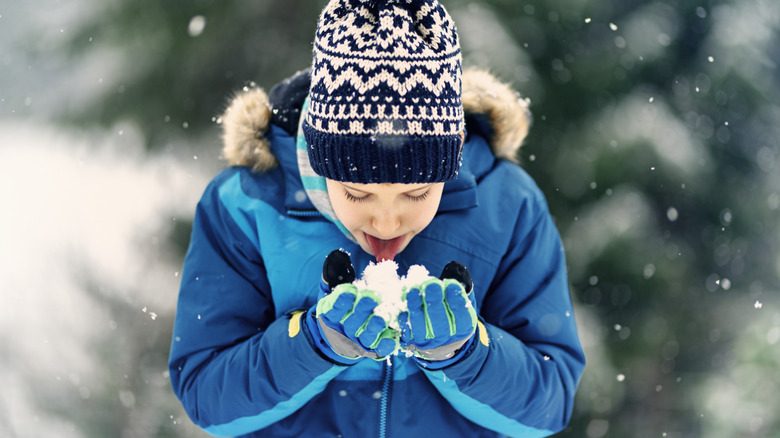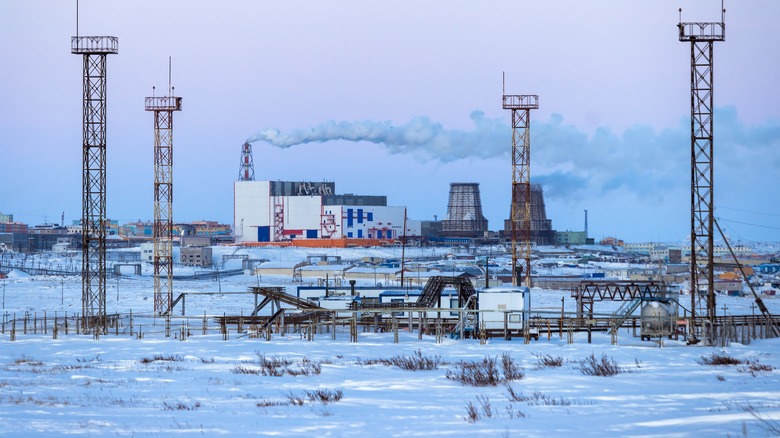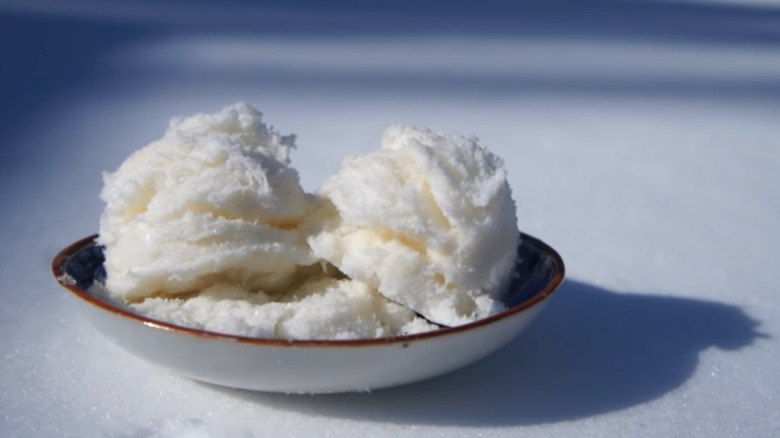Is It Actually Safe To Make Ice Cream Out Of Snow?
For many of us, our favorite foods are based in nostalgia. Dishes infused with fond memories can transport us to another time and place, to childhood days long before the weight of the world began to settle upon us. Ice cream is certainly one of those foods, typically evoking flashbacks of summer. But for some of us, there's a special type of ice cream that calls to mind the snowy months of winter instead
Snow cream is a unique take on ice cream that's made from freshly fallen snow mixed with sugar, vanilla extract, and your dairy of choice (typically cream or condensed milk). It's a sort of halfway point between ice cream and sorbet, although recipes from decades past often incorporated raw eggs for a more custardy texture.
There is a lot of historical precedent for snow cream. It may even be one of the earliest iterations of ice cream ever made. The Roman Emperor Nero reportedly sent slaves to harvest mountain snow, which he would mix with honey and fruit, and the Inuit have long enjoyed Alaskan akutaq, a frozen treat made from snow and animal fat. But as times change, and humans pump more pollutants into the air, concerns have arisen about the safety of snow cream. Scientists generally consider it okay, but only under certain conditions.
The risks of making snow cream
There's nothing inherently dangerous about snow itself — it's just water, after all — but the problem is that snow can pick up pollutants in the atmosphere as it falls to the ground. The EPA explains that volcanoes and ocean emissions release mercury into the air, which can drift over thousands of miles before being carried back down to earth in precipitation. Forest fires fill the air with formaldehyde, and the decomposition of organic materials releases sulfur. Fossil fuels also release sulfur and formaldehyde, and the black carbon unleashed by burning coal is particularly dangerous, potentially causing heart and lung problems. All this means is that the air isn't as clean as you think it is.
But that's not all. Once snow settles on the ground, it can pick up even more pollutants in the form of dirt, agricultural chemicals, and animal waste.
Thankfully, scientists generally agree that the danger is minimal since snow contains only tiny amounts of pollutants, far below the levels considered toxic for humans to consume. A cup of snow cream is highly unlikely to harm you, although there are some reports of people getting upset stomachs from eating very large amounts of snow. Moreover, there are precautions you can take to ensure you make snow cream in the safest way possible.
How to safely make snow cream
While you're probably safe eating most snow, if you want to make snow cream and avoid as many pollutants as possible, there are a few things to consider, starting with your location. If you are in a rural area, there will be fewer pollutants in the air because there aren't as many vehicles and buildings pumping out potentially harmful emissions. However, if there is a large farming industry in the region, there could be a higher risk of chemical pollutants seeping into the ground. One easy way to avoid ground pollutants in your snow cream is to catch the snow directly from the air. You can do this by putting a bowl outside for a few hours, or even overnight.
To avoid pollutants in the air, you've got to get the timing right. According to NPR, snowflakes are like little nets that capture pollutants on their way to the ground. That means the first few hours of snowfall are more likely to contain pollutants, but after that point, the air should be cleaner, making it the best time to harvest snow for snow cream.
If you're feeling like snow cream isn't for you, or you simply live in a snowless area, don't worry. It's quite easy to make ice cream (even without a machine) in the comfort of your home.


